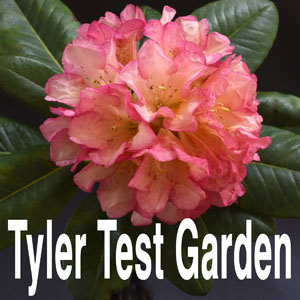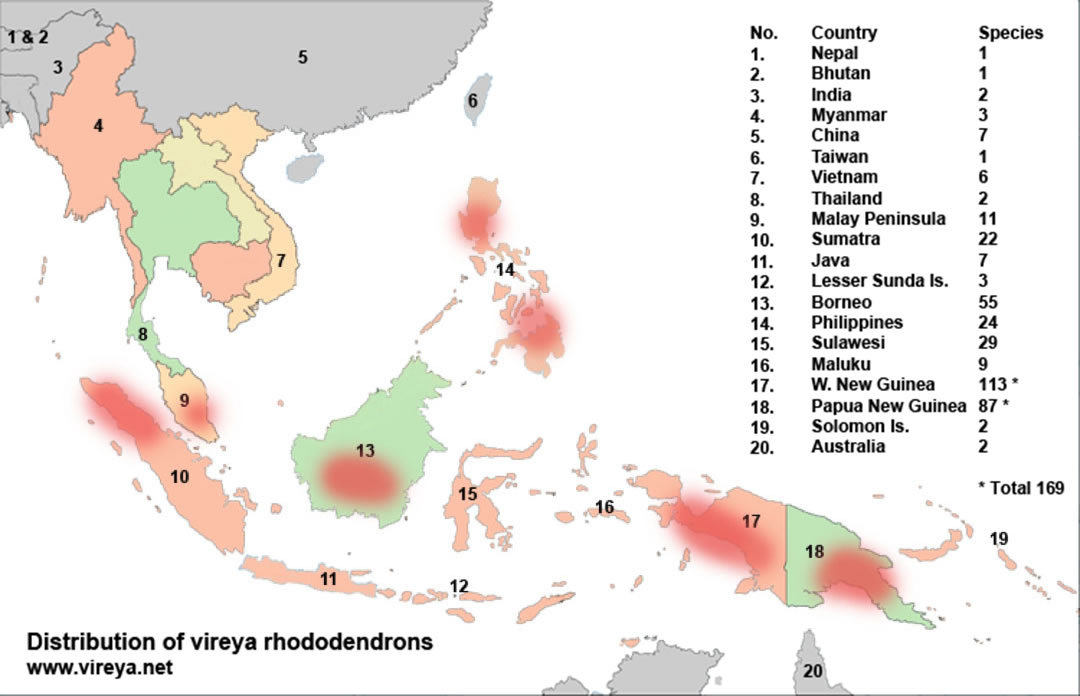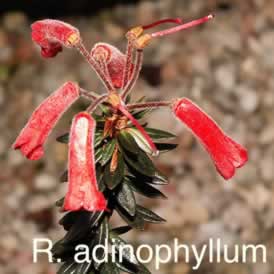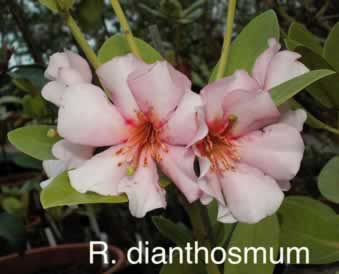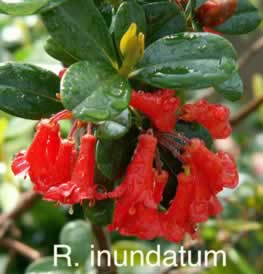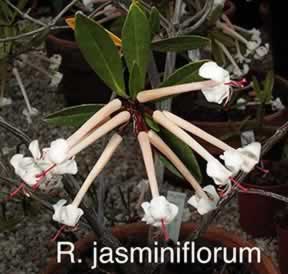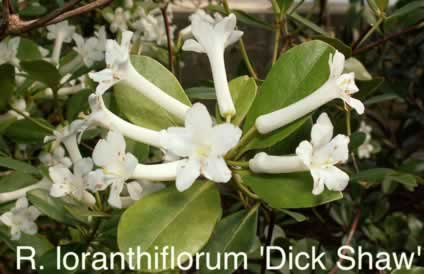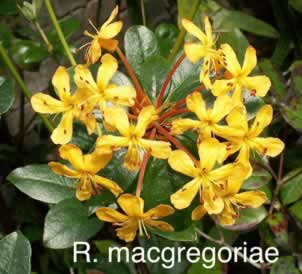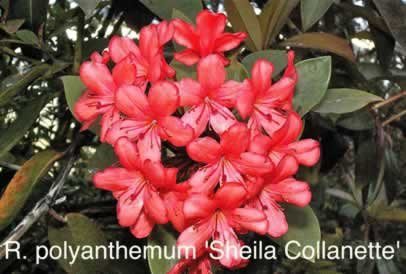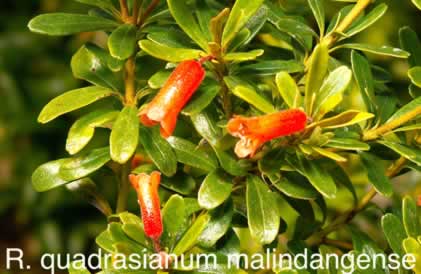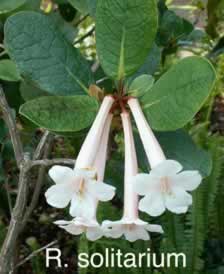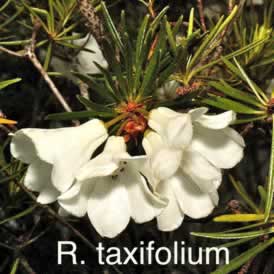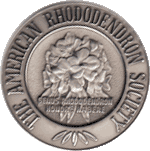R. adinophyllum, N. Sumatra, 2,600 to 3,450 m. Flowers tubular. Terrestrial. R. dianthosmum, Tropical evergreen shrubs with broadly elliptic leaves covered with brown scales. The tubular funnel-shaped flowers are white and smell like carnations. An attractive, upright-growing and bushy species with fragrant flowers. Native to New Guinea where it is found growing as an epiphyte from 1,650 to 4,600 ft. R. gardenia, Indonesia & New Guinea, terrestrial, flowers are scented, named after the genus Gardenia, also has white scented flowers. R. inundatum, Indonesia & New Guinea, terrestrial, flowers are trumpet shaped, name refers to the seasonally flooded area in which this species was
R. jasminiflorum, Small tropical evergreen shrubs with elliptic to rounded, glossy-green leaves arranged in a pseudowhorl. The fragrant flowers are white or white flushed pink with a long tubular corolla and abruptly flared lobes. A widespread and variable species typically growing as an epiphyte but also terrestrial in various situations. Native to peninsular Malaysia from 3,800 to 5,000 ft. R. loranthiflorum, Solomon Islands, Bougainville Island. Introduced in 1964 by Australian, Lyn Craven. Epiphytic in high rain forest and in stunted forest on crater rims, 180 to 1500 M or 500 to 4,900 feet in altitude. It is very floriferous and covered with masses of white fragrant flowers several time a year. R. macgregoriae, Large tropical evergreen shrubs or small trees (typically much smaller in cultivation) with ovate-lanceolate leaves in pseudowhorls. The leaves are smooth on the upper surface and more or less scaly beneath. The tubular flowers are light yellow to orange, pink or red, often with a yellow tube and orange lobes. Easily grown and floriferous, this is one of the best vireyas for the beginner. A common species throughout New Guinea where it occurs in a wide variety of habitats from 1,600 to 10,800 ft. R. polyanthemum 'Sheila Collanette', Large tropical evergreen shrubs or trees. The new growth emerges densely covered with tan scales, quickly changing to a bright orange-brown for an extremely attractive appearance. The fragrant bright scarlet to orange flowers are arranged in dense umbels. Rarely seen in cultivation, this species combines outstanding foliage with beautiful brightly colored flowers. Native to Malaysia (N Sarawak and Sabah) where it is found in mossy forests from 4,200 to 7,500 ft. The clone Sheila Collenette is named after the original collector of this species. [Return to Vireya Species List]
R. quadrasianum malindangense, Philippines, mostly terrestrial, flowers are usually solitary or in pairs, 1,000 to 1,600 m., named after mountain on which first collected. R. retusum, Tropical evergreen shrubs or small trees with small obovate to elliptic leaves in pseudowhorls. The cylindrical to narrowly funnel-shaped flowers are red. A long and heavy blooming attractive species. Native to Indonesia (Java and Sumatra) where it occurs from 4,300 to 11,100 ft. This was one of the earliest Vireyas to be introduced, and was featured in the 'Curtis's Botanical Magazine' in 1855. R. retusum is a reliable bloomer. Its bright red, small tubular flowers appear frequently. R. solitarium, Tropical evergreen shrubs with rounded-elliptic leaves arranged in pseudowhorls. Young shoots and leaves covered with rusty scales, foliage becoming dark shiny green above. The white flowers are tubular, becoming widely funnel-shaped at the lobes, with scales on the outer surface. Native to Papua New Guinea where it grows solitary on old gold-mine tailings and slopes among grasses and shrubs from 6,000 to 9,000 ft. R. taxifolium, Philippines, 2.600-2,700m (8,500 to 8,850 ft.) A threatened species in the wild because of illegal incursions by farmers. It is an easy plant to grow and flower reaching 3 feet in the wild. The leaves are small and narrow (like Taxus, Yew trees). The flowers are tubular-sub-campanulate and are white without fragrance. Very unusual small plants. [Return to Vireya Species List] How To Grow Vireya Rhododendron SpeciesTo successfully grow vireyas use 40% coarse perlite, 40% conifer bark mini-nuggets and 20% coarse peat moss for the potting mix. These plants do quite well when the roots become crowded; therefore, do not move up in pot size prematurely. Fertilize every four months with orchid fertilizer of liquid fish emulsion, together with chelated iron and Peters trace elements. Thorough watering is done once per week, allowing full drainage (not wet feet) in a dry apartment, but can be as infrequent as every ten days in a solarium or greenhouse full of plants and humidity. You must pinch and prune often to encourage a more compact growth in any vireya, especially when the plant is young. Pinch any solitary growing branch, even when the plant is only a few inches tall, until the vireya is three years old. Thereafter, pinch the new center growth as soon as the leaves start to develop and you know it is not a flower bud. The beginner can wait until the buds starts to grow either as leaves or flowers before attempting to differentiate between the two. Flower buds start at three to five years of age so after that the vireyas must be pruned ruthlessly. After all, Mother Nature frequently does this in the wild by freezing the top growth down to the ground. Prune the leggy types; don't bother to pinch them. You see, lepidotes have dormant adventitious buds all over so they will sprout out after pruning. Just remember to prune evenly back to the lowest set of leaves. The apical dominance theory works here. If the plant is not pruned evenly, the topmost branch will be the one that grows at the expense of the lower branches. After the plant is four years old, you may cut back one-third of the plant each year. Once a month, rose fungicide must be sprayed on all leaves until it runs off to combat powdery mildew. Mildew can build up tolerance; therefore, it is best to rotate between the mildew fungicides. Use 1 teaspoon per gallon of water, or 1 drop in 1/2 quart for hand sprayers. Always be alert for this disease and spray immediately if you see it. Red spots are caused by a magnesium deficiency, and yellow leaves are from chlorosis or from a calcium deficiency. Use dolomite or gypsum, chelated iron or liquid iron. You may use ammonium sulfate (never the nitrate). Black leaf tips are from salt burn. Flush out the pot to cure it. Directory of Contents for Henning's Rhododendron & Azalea Pages •• Providing Information about the Genus Rhododendron since 1996
••
Articles Published by the American Rhododendron Society
Compatibility & Webmaster information: These pages were created in Adobe GoLive, Adobe DreamWeaver, and BBEdit by Steve Henning rhodyman @ earthlink.net [In the news: 2012 ARS Silver Award, 2019 ARS Gold Award.]
Last Updated:
July 6, 2020
|

